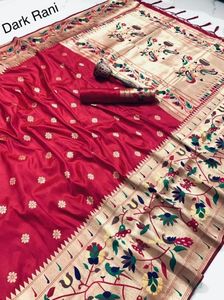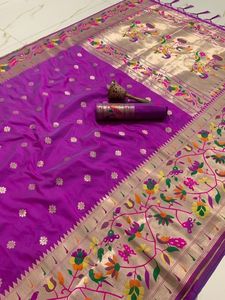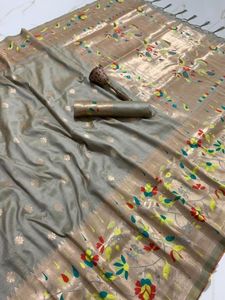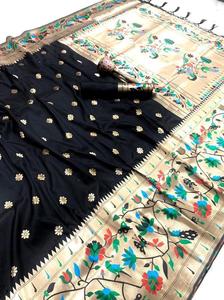(80332 products available)




























































































































































Plain sarees with border and designer blouses are traditional Indian garments consisting of a simple, unadorned fabric with a bordered border and an elaborately designed top. Here are some types of these sarees:
Silk Saree with Golden Border
Typically, the material of choice for these sarees is silk, which is renowned for its exquisite texture and luster. The border is made to enhance elegance through rich golden zari work. The result is a stunning contrast of a plain body and an ornate border. This type of saree is commonly worn at weddings and other ceremonial occasions. The golden border raises the glamor of the attire, making the wearer look royal.
Cotton Saree with Colorful Border
Here, the fabric used is cotton, and the border is made to have a colorful look. These sarees are comfortable to wear, especially during the hot season. They are distinguished by a simple look and a vibrant border. The border adds to the beauty of the saree without overwhelming the simplicity of the fabric. This type of saree can be best worn on casual occasions. They can also be worn daily because they are simple to wear and remove.
Georgette Saree with Sequin Border
Often, georgette sarees are chosen for their lightness and translucent nature. Their border is adorned with sequin embroidery to give them a touch of sparkle. The saree’s body remains plain, so the border and sequins become the focal point. Since the material is light, it drapes beautifully over the body, making it ideal for evening and party wear. The sequins twinkle under light, making the wearer stand out.
Chiffon Saree with Lace Border
These sarees have a lace border that brings a touch of delicacy and romance to the plain chiffon fabric. Chiffon is known for its lightweight and flowy nature. As a result, it drapes beautifully. The lace border adds texture and intricate detail, enhancing the elegance of the saree. These sarees are ideal for formal events and evening wear because of their soft and feminine look.
Net Saree with Velvet Border
This saree combines the sheer, airy fabric of net with the rich texture of velvet in its border. The net fabric is usually left plain or with minimal embellishments, allowing the velvet border to stand out. These sarees are particularly popular for weddings and high-end parties. The velvet border adds a luxurious feel, making the attire opulent.
Plain sarees with borders and designer blouses offer a canvas of simplicity on which diverse, intricate, and vibrant designs can be painted. These sarees are very common in India and other countries where sarees are traditional. The saree is a long piece of cloth, usually about six meters long, and the blouse is a tight-fitting garment worn under it. The border of a plain saree is the edge of the fabric, while the design can be anything from intricate embroidery to simple geometric shapes. Here are some of the elements that make up the design of these saree and blouse combinations.
Saree Design
Sarees are available in various designs. Some designs are based on the material the saree is made of, while others are based on cultural or regional traditions. Here are some of the common design elements:
• Plain saree with border– The plain saree is the most versatile type. It has no color or pattern and is suitable for any occasion. It is good for work and daily use. The border gives the saree a finished look and can be simple or elaborate. A simple border may be a line or a small geometric pattern, while an elaborate border may have flowers, birds, or other motifs along the edge.
• Embroidered Borders – Some sarees have embroidered borders. The embroidery can be simple stitches or complex designs. It adds texture and visual interest to the saree. The embroidery thread may be of a different color from the saree or shine in the light to create a contrast.
• Patterned Borders – These borders have patterns like waves, zigzags, or florals. The patterns are usually repeated along the length of the border. Patterned borders can make a plain saree look more festive.
• Color – The color of the saree can reflect the wearer's personality or mood. Some colors are associated with specific events or times. For example, white sarees are worn at funerals, while red sarees are worn at weddings. A plain saree with a colored border can give the wearer a bridal look even if she is not getting married.
Blouse Design
The blouse is an important garment because it can complement or contrast with the saree. Here are some of the key design elements:
• Cut – The cut refers to how the blouse fits. It may be loose or tight. A loose blouse is comfortable for daily use, while a tight blouse makes the wearer look more formal and elegant. The cut can highlight the wearer's body shape.
• Collars – The collar style can change the look of the blouse. Some collars are round, while others are V-shaped. A round collar is simple and good for work. A V-collar may be more formal and suitable for events.
• Sleeves – The sleeves may be long, short, or sleeveless. Long sleeves cover more of the arm and are modest. They may have embroidery or patterns. Short or sleeveless blouses are cooler and better for hot weather.
• Patterns – Designer blouses may have patterns like checks or flowers. These patterns add visual interest. Some blouses have patterns on the sleeves or back. These patterns can make the blouse look more festive.
• Back Design – The back of a designer blouse may have intricate patterns or embroidery. Some blouses have a back opening secured with hooks or a zipper. These elements can make the blouse look elegant and stylish.
Wearing a plain saree with a border and a designer blouse is a classic and elegant choice that can be suitable for various occasions. To wear this attire, start by draping the saree around the waist, making sure the lower edge is at an appropriate length above the ground to avoid tripping. Tuck the end of the saree into the waistband on the right side, then wrap it around your body once more before tucking it in again. Depending on the style, continue draping the saree in pleats or by folding it over your arm. Secure the saree in place with a few safety pins, ensuring a comfortable and secure fit. Finally, adjust the pallu, which is the decorated part of the saree, over your shoulder, and make any necessary adjustments to the overall drape.
Wearing a plain saree with a border and a designer blouse is a classic and elegant choice that can be suitable for various occasions. To wear this attire, start by draping the saree around the waist, making sure the lower edge is at an appropriate length above the ground to avoid tripping. Tuck the end of the saree into the waistband on the right side, then wrap it around your body once more before tucking it in again. Depending on the style, continue draping the saree in pleats or by folding it over your arm. Secure the saree in place with a few safety pins, ensuring a comfortable and secure fit. Finally, adjust the pallu, which is the decorated part of the saree, over your shoulder, and make any necessary adjustments to the overall drape.
Pairing a designer blouse with a plain saree can be a stunning combination. Choose a blouse that complements the color and style of your saree. For a bold look, opt for a blouse with intricate embroidery or embellishments, even if the saree is plain. If the saree has a vibrant color, a contrasting blouse in a different color can make a striking appearance. Alternatively, for a more subtle and sophisticated look, select a blouse in a similar shade to your saree but with a different texture or a slightly varied hue.
Accessorizing appropriately can enhance the overall look. Statement jewelry, such as chandelier earrings or a chunky necklace, can draw attention to the blouse and elevate the outfit. For a more understated look, consider delicate jewelry pieces like thin bangles or small studs. A matching clutch or potli bag can complement the attire and add a touch of elegance.
Matching a plain saree with a border and a designer blouse involves considering color coordination, style, and occasion to create a cohesive and elegant look. Start by selecting a blouse that complements the saree's color and texture. For a plain saree with a contrasting border, choose a blouse in a color that harmonizes with both the saree and the border. For instance, a white or beige saree with a red or blue border can be paired with a blouse in a matching border color or a contrasting yet complementary shade like gold or cream.
When it comes to the designer blouse, consider the level of embellishment and detailing. If the blouse features intricate designs, embroidery, or embellishments, ensure that the saree remains relatively simple to balance the overall look. Conversely, if the blouse is relatively simple, you can opt for a more elaborate saree with additional details. The key is to maintain balance without one element overpowering the other.
Consider the neckline and sleeve style of the designer blouse as well. Blouses with high necklines or closed necks can be paired with elegant sarees for a sophisticated and regal look. Off-shoulder or boat-neck blouses add a contemporary touch and can be styled in a modern way. Pay attention to the fit and tailoring of the blouse to ensure a flattering silhouette that enhances the wearer's body. The fit should be comfortable and well-tailored, highlighting the wearer's figure without being too tight or restrictive.
Accessorizing plays a crucial role in completing the ensemble. Choose jewelry that complements both the saree and the blouse. Statement necklaces, earrings, or bangles can enhance the overall look. For a more traditional approach, consider wearing antique or temple jewelry that complements the saree's aesthetic. A matching clutch or potli bag can add a touch of elegance and coordination to the outfit.
Q1: What are the characteristics of a saree with a border?
A1: A bordered saree has distinct edges. The border stands out from the rest of the saree. It may be wider or patterned differently. This design adds contrast and frames the saree. Borders can include weaving, printing, or embroidery.
Q2: What are the different types of borders in sarees?
A2: Saree borders come in various styles. Some are wide and prominent, while others are narrow. Borders can be plain or have patterns like stripes or checks. They may also feature embroidery or zari work. Zari borders are well-liked for their metallic thread work. Designers can customize bordered sarees in numerous ways to meet clients' needs.
Q3: What are the advantages of a bordered saree?
A3: Bordered sarees are versatile and elegant. They suit different body types and occasions. The border design enhances the saree's visual appeal. It frames the wearer and creates a balanced look. Bordered sarees are easy to drape and style in different ways. They are ideal for both casual and formal events.
Q4: What are some tips for choosing a bordered saree?
A4: Consider the occasion and personal style. Different sarees suit different events. The border design should complement the draping style. Lighter bordered sarees are suitable for daily wear. Darker shades are ideal for festive occasions. Blouses can match or contrast the border. Think about the overall look.
Q5: How can one care for and maintain bordered sarees?
A5: Hand wash bordered sarees in cold water. Use mild soap or detergent. Avoid wringing or twisting the saree. Lay it flat to dry. Steam iron on low heat to remove wrinkles. Iron in the direction of the weave. Store the saree in a dry place. Fold it neatly and keep it away from direct sunlight.